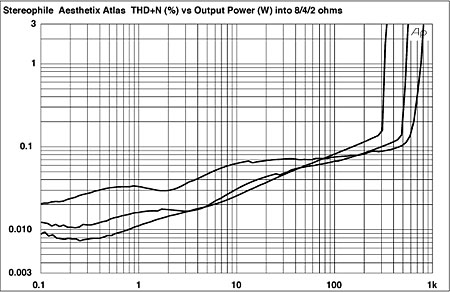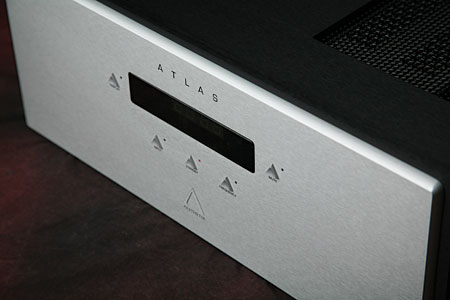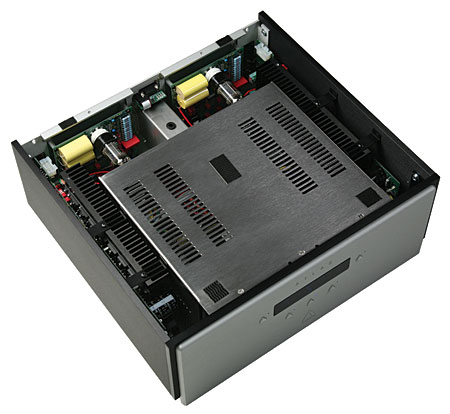Aesthetix Atlas Stereo Power Amplifier
R90,000.00
- The Absolute Sound, Product of the Year Awards, 2020
- What Hi-Fi?, 2015
There are no hard edges here, no tendency to harshness, even with less than perfect recordings. Yet the unusual thing here is that these components – the pre and power share the same sonic character – partner this civility with sledgehammer muscle when required. That combination of abilities is rare, even among the priciest of products. We’re struck by the solidity of the sound first, followed by the clean and precise way this amplifier defines the shape of the piano notes. There’s just so much detail on offer, with the Aesthetix delivering a full dose of the harmonic richness of the instrument. - HiFi+, 2014
The first difference you notice is the velvety black background silence. From there, an incredible transparency emerges, revealing a new richness of subtle musical information and spatial imaging. The next thing to hit you will be the clarity of focus and stunning coherence, where every part of the music comes together and all elements are articulately focused and united in every moment, with no time smear or blurring. This in turn gives a stunning dynamic impact: since all parts of every musical note are united at the same moment, they all add up to a higher transient peak, thus reproducing the recording’s dynamics much more accurately. - HiFi+, Roy Gregory, 2014
These amps are good enough and communicative enough to put you really close to the performers and their performance. With unforced power and a real sense of presence, they project music with an uncannily natural sense of pace, flow and colour. The Janus, despite the astonishing value, will clearly only appeal to those who use, or want to get back into using, vinyl. That makes the cost of the phono-stage in the Janus pretty much a revelation to many listeners – especially those used to the one size fits all approach adopted by so many manufacturers. It’s not until you use these Aesthetix electronics together that you realize their full potential – and believe me, that potential is considerable! - The Audio Beat, Roy Gregory, 2014
The Janus and Atlas Signature models can form a solid, beating musical heart, right at the center of such systems. Listen to them and I think you will be shocked by just how much musical energy they deliver, the authority with which it arrives and just how much sense it makes when it does. Considering that, as far as Aesthetix are concerned, these products are one notch above entry level, I find it remarkable just how completely satisfying they are to use. For Aesthetix, they may well only be one rung up the performance ladder, but for many a listener they are going to represent an approachable, practical and musically satisfying endgame — just the endgame many of them will have been seeking out for many a long year. - Stereophile, Wes Phillips, 2010
Naming an amplifier after the Titan who supported the firmament—or the world itself—is a gutsy thing to do. However, Jim White’s Aesthetix Atlas makes a strong case for a power amp being the structural support of a hi-fi system. Certainly, the construction and quality of the Atlas are in keeping with its namesake. But for all its strength and grunt, the Aesthetix Atlas revealed itself to be quite graceful in its portrayal of music and music’s physical, insubstantial substance…It’s one of the really great amplifiers I’ve had in my system recently, and I hope I’ll be listening to it even more in the months to come. - What HiFi?, 2008
In overall terms, it remains the best we’ve heard at this price level or anywhere near it.
In Greek mythology, Atlas was the Titan who supported the heavens—although he’s more commonly shown supporting Earth itself. (Funny thing, that: the globe he was always shown supporting actually did once represent the cosmos, but at some point became the Earth.) According to Hygenus, Atlas was the son of Aether, the personification of the sky and heaven, and Gaia, the personification of the Earth. Atlas was brother to Prometheus (foresight), Epithemius (hindsight), and Menoetius (a warrior whose insolence got him smitten by a lightning bolt from Zeus, resulting in a name synonymous with “ruined strength”).
In other words, Atlas was a heavy hitter; if you name something after him, it had better be spectacular. Jim White, chief designer and head honcho at Aesthetix Audio, was surely aware of all this when he had the chutzpah to name his 200Wpc hybrid power amplifier after the brawny Titan. The question is, was he justified in that confidence?
Mapping a Titan
The Atlas ($8000) is a hefty beast at 70 lbs, and is wrapped in an aluminum enclosure that surrounds the circuits and heatsinks in a cage-in-cage construction. The Atlas’s two transformers and three chokes are housed under a stainless-steel cover to prevent magnetic fields from interfering with the audio circuitry. The B+ tube power-supply is discretely regulated with each channel’s driver stage supply separately regulated. The 1400VA transformer feeds a choke, which in turn feeds the high-current output section..The voltage gain stage employs one 6SN7 tube per channel. The current-amplifying output stage, designed in conjunction with Ayre Acoustics’ Charles Hansen, uses 16 bipolar output devices per channel and there is no global negative feedback. Each channel’s output devices are connected by massive copper bus bars, which radically reduces impedance, according to White, though it is fair to note that the Atlas has a relatively high specified output impedance of 0.25 ohm. The Atlas’s construction and circuit layout appear to be superlative.
An unusual feature of the Atlas is its 6dB/octave high-pass crossover, which can be set to 16 different values between 40 and 200Hz. It’s handy if you use a subwoofer (or a loudspeaker with a powered subwoofer, such as the Vandersteen Quatro Wood); if you don’t, it’s easily defeated with a direct-input bypass.
The Atlas’s front panel features a largish LED display (for a power amplifier), and five contact switches, which control power, illumination, and the high-pass crossover-frequency submenu. The rear panel accommodates single-ended and balanced inputs. The binding posts are the single-knobbed Cardas design. There are also RS-232 and remote trigger inputs, as well as a fused AEC mains plug.
Atlas unmoved
Setup was a breeze. There are no switches with which to choose single-ended or balanced operation, so the Atlas is plug’n’play—unless you want to use the high-pass filter, which requires accessing the submenu. None of the speakers I had on hand required the filter, so that wasn’t an issue.The Atlas is heavy and benefits from good ventilation, so proper support and placement are required. The amp doesn’t get hot so much as quite warmish. Also, while the Atlas has five rubber feet, which damp the underside of its chassis fairly well, I discovered that it benefited from aftermarket footers—I cycled through brass cones, DH Labs ceramic cones, and ultimately settled on Ayre’s blocks of myrtle wood. If you feel an $8000 amp shouldn’t require aftermarket mods, you’re welcome to skip them, but I found the Ayres added a touch more, um, air (or, alternatively, eliminated a slight amount of chassis ringing). I also scattered a few myrtle blocks on the amp’s top plate, a conceit that amused my cats, who would sweep them off before settling down for a heated nap. (Cats, too, do a good job of damping the top plate, but they’re unreliable suckers.)
I listened to the Atlas driving three different pairs of speakers: Klipsch’s F-39 Palladium, Thiel’s CS3.7, and Vienna Acoustics’ Klimt The Kiss. None—not even the Thiels—seemed to challenge the Atlas’s rock-solid control.
Heavenly Music
Control, ease, and dynamic command were the first properties I noticed about the Atlas. It took charge of a pair of loudspeakers and made ’em behave.From the Tin Hat Trio’s Memory Is an Elephant (CD, Angel 56786), “The Would-Be Czarina” had a timbral correctness that made the trio’s subdued dynamic range really pop. Released on Angel, ostensibly a classical label, the THT’s version of chamber music has haunting undertones. This track begins with Mark Ortron’s jangly guitar juxtaposed over sustained chords from Carla Kilstedt’s viola. The Atlas gave the duo a vividness that belied their pianissimo level. Later, the two instruments exchange places, leaving Rob Berger’s asthmatic organ chords to handle the fundamental. “The Would-Be Czarina” seems simple, but it’s not—through the Atlas, it was vivid and engrossing.
-
On Los Lobos’ live cover of Cream’s “Politician,” from Just Another Band from East L.A. (CD, Slash 45367-2), David Hidalgo’s lead guitar had all the screaming assertiveness of Clapton’s original. The Atlas gave the band the appropriate heft of a heavily amplified rock band in a large venue. Through the Atlas, the track rewarded play after play, at increasing loudness. No, you can’t reproduce the concert experience at home, but the Aesthetix proved you can get satisfyingly close.Of course, that level of audio verité wasn’t all the Atlas’s doing—almost every rock track I played after “Politician” sounded flat in comparison. That said, my experience has been that truly great components accentuate the differences between great and merely good recordings, whereas ordinary hi-fi flattens the effect. The Atlas made Los Lobos jump to life.

The Hilliard Ensemble’s performance of the Introitus of Orlando di Lasso’s Missa Pro Defunctis (CD, ECM New Series 1658) had a hushed intimacy that nevertheless filled the chapel acoustic of the Boxgrove Priory, in Chichester. Gordon Jones’s baritone rooted the sound with palpability, letting tenors John Potter and Rogers Covey-Crump flesh out Lasso’s moving blocks of sound, as over it all soared countertenor David James. What the Atlas got right about the Introitus was that it was simultaneously physical and ethereal. The voices floated—but they also collided against one another. And for all the beauty of the four voices working through Lasso’s winding, soaring melodies, the hushed resolution of the final major chords is a physical release. The Atlas got so much so right—Introitus was an eargasm.
Charles Mingus’s “Cumbia & Jazz Fusion,” from the eponymous album (CD, Atlantic 8801), shares with Mahler’s music an emotional complexity as well as a rootedness in folk melodies. After a relatively simple opening, “Cumbia” rocks out, buoyed above Mingus’s heavy bass line. Various instrumental choirs trade phrases with one another, separated by Ellingtonian ensemble choruses. It’s a 28-minute journey into a complex soundscape—always, but especially so through the Atlas.
Titan vs Olympian
I’d been lucky enough to hang on to the Parasound Halo JC 1 monoblocks until early fall, so it seemed appropriate that I compare them to the identically priced Atlas. I was about to joke that it’s a tough job that somebody has to do, but the fact is, comparing amplifiers as good as the Parasound and the Aesthetix is hard work. Apples to oranges is an easy comparison—but McIntoshes and Park’s Pippens? That’s tougher.The Atlas revealed more midrange presence in the Tin Hat Trio’s “The Would-Be Czarina”—not an astonishing amount, but the song had a tad more three-dimensionality with the Aesthetix. One thing both amps got right, however, was the overall timbral balance. This music is light as air, and both amps remained true to that delicacy.
While I thought the Atlas got the midrange righter, the JC 1s had more top-end extension. This is an area of endless debate among audiophiles: extension or midrange timbre? It’s a matter of preference, in my opinion, and not so much one of right and wrong.
As for Los Lobos’ “Politician,” while I felt that the Atlas had all the slam needed for kick-ass rock’n’roll, the JC 1s had even more wallop—and, again, a little more HE extension, although I thought it bordered on too much. However, “bordered on” is far from actually being too much. I wouldn’t call the JC 1s wrong, and another listener might well call them spot-on.
I was less equivocal about the amplifiers’ reproductions of Lasso’s Introitus, although again, the differences were extremely subtle. The Atlas’s creamier midrange brought the Hilliard’s four voices more vividly to life for me, and placed them deeper in the acoustic. The JC 1s, I felt, were a tad less vibrant in the middle, and just the slightest bit flatter for it.
On Mingus’s “Cumbia & Jazz Fusion,” however, the monoblocks did a better job of distinguishing among all of the elements Mingus threw into the piece—the bird calls, percussion, and various folk instruments that populate the field behind the sonic foreground of this big band. There was also no doubt that Mingus’s bass (which is rumored to have been amplified for this, his final recording) had a lot more body and slam through the Parasounds. That’s not to say the Aesthetix was without its charms; its ability to wrest color from the midrange gave it an immediacy that also attracted me, if slightly less than the JC 1s.
This Atlas didn’t shrug
Naming an amplifier after the Titan who supported the firmament—or the world itself—is a gutsy thing to do. However, Jim White’s Aesthetix Atlas makes a strong case for a power amp being the structural support of a hi-fi system. Certainly, the construction and quality of the Atlas are in keeping with its namesake.But for all its strength and grunt, the Aesthetix Atlas revealed itself to be quite graceful in its portrayal of music and music’s physical, insubstantial substance. No one could call the Atlas a “bargain” at $8000, but neither could they gainsay its worth. It’s one of the really great amplifiers I’ve had in my system recently, and I hope I’ll be listening to it even more in the months to come.
Description
The Aesthetix Atlas amplifiers are capable of driving virtually any high quality speaker. An innovative hybrid design incorporates a bipolar output stage, bipolar driver stage, and vacuum tube input gain stage. They stand alone as the only hybrid amplifiers with zero feedback, essential for maintaining harmonic integrity, air, space and coherence. The Atlas provides your choice of full range or high-pass inputs. This unique built-in filter is ideal for speakers featuring powered woofers, or for audio and home cinema systems using outboard powered sub-woofers. Saturn Series design themes are evidenced in the specialised all-aluminium chassis construction and elaborate power supply design. The Atlas has enjoyed worldwide acclaim for its sound quality, build quality, flexibility and ease of use.
The Atlas has the following features:
- Zero feedback, fully differential amplifier with complementary balanced bridge design for open sound.
- Tube gain stage using one 6SN7 tube per channel provides harmonic accuracy and soundstage layering. This single gain stage provides all of the voltage gain for the entire amplifier.
- Stereo amplifier: 200 watts per channel into 8 ohms; 400 watts per channel into 4 ohms
- Amplifier has a built-in high-pass crossover: 6 dB / octave, 16 settings from 40 Hz to 200 Hz in approximate 10 Hz increments.
- Single-ended and balanced inputs provide extended compatibility.
- Direct input bypasses all crossovers and switching for ultimate purity.
- Bus technology reduces power supply impedance between output devices for more instantaneous current.
- Power supply uses two transformers and three chokes. The high current section uses a dedicated transformer and choke input power supply. The vacuum tube B+ power supply has choke input and is discretely regulated. The result is unequalled clarity and control.
- Cardas patented rhodium-plated binding post with single knob lockdown.
- All aluminum chassis construction assures durability.
- Stainless steel cover for transformers prevents magnetic fields from interacting with sensitive audio circuitry, preserving low level musical nuances.
- RS232 control and trigger for special installation requirements.
All of this attention to detail has resulted in a power preamplifier that transcends what is normally expected from an audiophile piece of equipment. The Atlas scales heights that are normally the realm of uber-expensive products and it does it with ease. Sound quality is the prime objective here and the Atlas is a phenomenal achievement. This value for money quality is spoken about in all the audio press and the Atlas has accumulated many awards & accolades. These reasons are why Aesthetix products have developed a passionate following around the world.
I plotted how the Atlas’s THD+noise percentage varied with output power using the less-noisy right channel, so that the result wouldn’t be obscured by noise at low powers. And at low powers into both 8 and 4 ohms (fig.4, bottom two traces below 10W), the THD+N was indeed low. As can be seen from this graph, however, it rose linearly with increasing power and reached approximately 0.13% before actual clipping, which suggests a low or zero degree of loop negative feedback. It was also significantly higher into 2 ohms (fig.4, top trace below 70W). With clipping defined as 1% THD, the Atlas comfortably exceeded its specified output power with both channels driven: fig.4 shows that it clipped at 318W into 8 ohms (25dBW), 535W into 4 ohms (24.3dBW), and, with one channel driven, at 760W into 2 ohms (22.8dBW).
Atlas Stereo
Power Output: 200wpc channel into 8, 400wpc into 4
Input Sensitivity: 60mV (1 watt), 2.3V (full power)
Atlas Mono
Power Output: 300wpc channel into 8, 600wpc into 4
Input Sensitivity: 60mV (1 watt), 3.1V (full power)
Input Impedance: 470K
Output Impedance: .25 at 1kHz
Signal to noise: 120dB
Bandwidth at full power: 4 – 150kHz
Rated THD at full power: <1%
Power consumption: 100 watts at idle
Dimensions: 18″w x 8″h x 19″d
Weight: 70 lbs
Finish: black or silver
Warranty: 3 years, non-transferable













